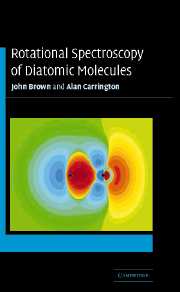Book contents
- Frontmatter
- Contents
- Preface
- Summary of notation
- Figure acknowledgements
- 1 General introduction
- 2 The separation of nuclear and electronic motion
- 3 The electronic Hamiltonian
- 4 Interactions arising from nuclear magnetic and electric moments
- 5 Angular momentum theory and spherical tensor algebra
- 6 Electronic and vibrational states
- 7 Derivation of the effective Hamiltonian
- 8 Molecular beam magnetic and electric resonance
- 9 Microwave and far-infrared magnetic resonance
- 10 Pure rotational spectroscopy
- 11 Double resonance spectroscopy
- General appendices
- Author index
- Subject index
- References
9 - Microwave and far-infrared magnetic resonance
Published online by Cambridge University Press: 17 December 2010
- Frontmatter
- Contents
- Preface
- Summary of notation
- Figure acknowledgements
- 1 General introduction
- 2 The separation of nuclear and electronic motion
- 3 The electronic Hamiltonian
- 4 Interactions arising from nuclear magnetic and electric moments
- 5 Angular momentum theory and spherical tensor algebra
- 6 Electronic and vibrational states
- 7 Derivation of the effective Hamiltonian
- 8 Molecular beam magnetic and electric resonance
- 9 Microwave and far-infrared magnetic resonance
- 10 Pure rotational spectroscopy
- 11 Double resonance spectroscopy
- General appendices
- Author index
- Subject index
- References
Summary
Introduction
Microwave magnetic resonance, which has often been called ‘gas phase electron resonance’, and far-infrared laser magnetic resonance have been extremely important techniques in the study of free radicals. These techniques depend upon the presence of a large magnetic moment for the species under investigation, because both rely on the ability to tune the energy levels with a magnetic field into resonance with fixed frequency radiation. Although historically the first study of the rotational levels and their fine structure involved fairly conventional swept-frequency microwave spectroscopy, applied to the OH radical, subsequent development of the subject depended initially on the success of magnetic resonance methods. Pure microwave spectroscopy of gaseous free radicals has now become almost routine, and many examples will be described in chapter 10. We have, after some deliberation, decided to present the exciting subject of magnetic resonance with due regard to its historical development. Nevertheless, this and the two following chapters should be taken together for a balanced view. Laser magnetic resonance techniques are still widely used, but microwave magnetic resonance has now been largely superseded by swept-frequency methods, without the presence of an external magnetic field. Zeeman effects can, of course, still be investigated, but they are not an essential part of the detection method.
Experimental methods
Microwave magnetic resonance
Electron spin resonance (e.s.r.) spectroscopy, applied to free radicals in condensed phases, is a long established technique with several commercially available spectrometers.
- Type
- Chapter
- Information
- Rotational Spectroscopy of Diatomic Molecules , pp. 579 - 682Publisher: Cambridge University PressPrint publication year: 2003

